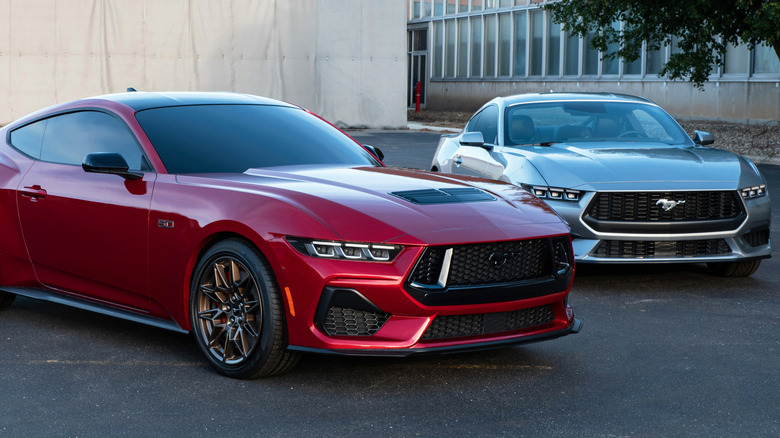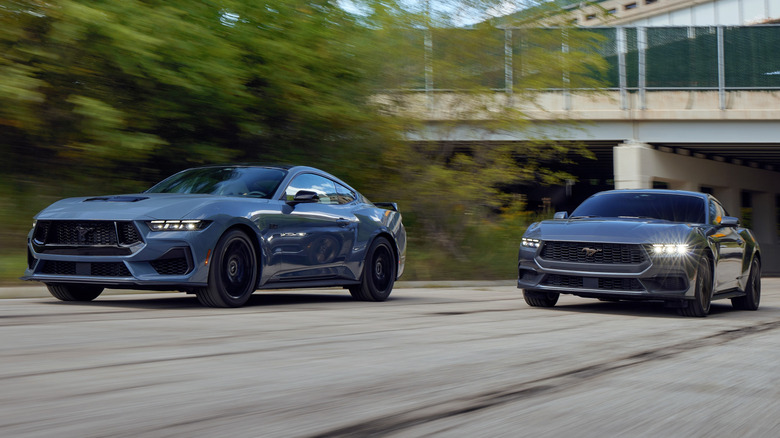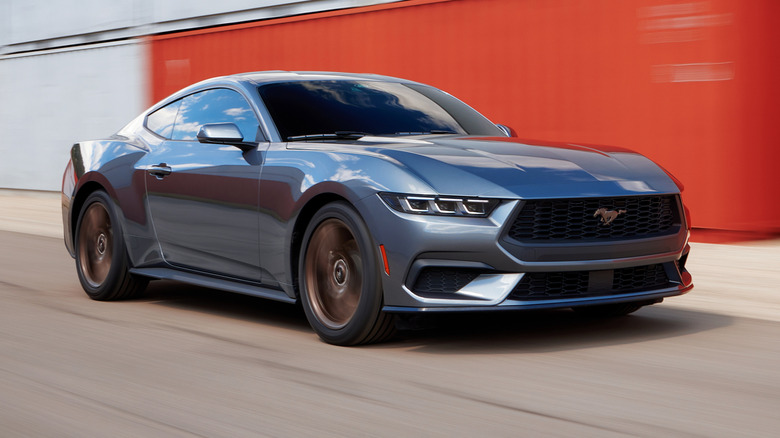How Fast Is The Ford Mustang EcoBoost Compared To The GT?
The Ford Mustang is one of the most famous nameplates in the world, and some significant credit must go to the powerful V8 engines that have featured in the car and allowed it to become such a crowd pleaser. But gas-guzzling, high-horsepower V8s aren't the only reason why the pony car has broadened its appeal since debuting in 1964. While consumers have traditionally been far more interested in V8 Mustangs over the years, smaller engines such as the inline-4 EcoBoost and V6 have gained some traction among buyers.
Introduced in the Mustang in 2015, Ford's four-cylinder EcoBoost has powered many base-model Ford Mustangs since then. It can produce power comparable to a larger engine while achieving good fuel economy through technologies like turbocharging, direct fuel injection, and variable camshaft timing. Despite the EcoBoost engine's commitment to improved fuel economy, it can hit 60 mph pretty quickly. For instance, a 2024 Ford Mustang EcoBoost with Performance Package can accelerate from 0 to 60 mph in 4.5 seconds, according to a Car and Driver test. In the seventh-generation GT Mustang, the V8 engine takes the Mustang to 60 mph three-tenths of a second faster, hitting the milestone in 4.2 seconds (via Car and Driver). The basic seventh-gen EcoBoost seems to be limited to a 123-mph top speed, while the GT's limiter kicks in at 155 mph.
How does the Mustang's EcoBoost engine compare to the V8?
One of the major differences between the EcoBoost and Mustang GT is the power output: the EcoBoost Mustang is at least 165-hp less potent, as its four-cylinder engine creates 315 hp and 350 lb-ft of torque in stock form. The Mustang GT's 5.0-liter Coyote V8 engine, on the other hand, generates a robust 480 hp and 415 lb-ft of torque. When equipped with an optional performance exhaust that improves airflow, the output increases to 486 hp and 418 lb-ft. But what it lacks in power output, the EcoBoost Mustang makes up for in fuel economy.
The EPA estimates that the EcoBoost Mustang can travel 26 miles on a gallon of fuel, on average, while an automatic-equipped Mustang GT is said to cover just 19 mpg with the same amount of gas. However, that return dips marginally to 18 mpg for a manual Mustang GT. Speaking of which, the 2.3-liter EcoBoost engine comes solely with a 10-speed automatic, while the Mustang GT's V8 can be had with either the 10-speed automatic or a six-speed manual. Each transmission sends power to the rear wheels, as is the case with every generation of the Ford Mustang.
What can you expect to pay for a Ford Mustang EcoBoost?
There are four Mustang models with the 2.3-liter turbocharged inline-4 EcoBoost engine: Mustang EcoBoost Fastback, Mustang EcoBoost Premium Fastback, Mustang EcoBoost Convertible, and Mustang EcoBoost Premium Convertible. The EcoBoost Fastback kicks off the line from $31,920 (before a $1,995 destination charge and a $695 acquisition fee). That outlay nets you features like a 13.2-inch touchscreen infotainment system, a 12.4-inch instrument cluster, Apple CarPlay and Android Auto, adaptive cruise control, and cloth seats.
The EcoBoost Premium Fastback provides a step up in luxury from the entry-level model, but charges $5,625 extra, with prices starting from $37,545. If you're set on a Convertible, the base-spec EcoBoost Convertible can be had from a base MSRP of $40,120, while stepping up to the EcoBoost Premium Convertible will cost you $43,045. The entry-level GT Mustang, meanwhile, comes only in coupe guise and starts at $46,560. If you're leaning toward the better-equipped GT Premium model, the coupe will set you back $51,080, while the convertible is available from $56,580 (all before $1,995 destination and $695 acquisition fees).


